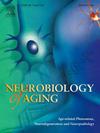Explaining tip-of-the-tongue experiences in older adults: The role of brain-based and cardiorespiratory fitness factors
IF 3.7
3区 医学
Q2 GERIATRICS & GERONTOLOGY
引用次数: 0
Abstract
Cognitive decline associated with healthy ageing is multifactorial: brain-based and lifestyle factors uniquely and jointly contribute to distinct neurocognitive trajectories of ageing. To evaluate existing models of neurocognitive ageing such as compensation, maintenance, or reserve, we explore how various known brain-based and cardiorespiratory fitness factors intersect to better understand cognitive decline. In a pre-registered study (https://osf.io/6fqg7), we tested 73 healthy older adults aged 60—81 (M = 65.51, SD = 4.94) and collected neuroimaging (functional, structural, and perfusion MRI), cardiorespiratory fitness, and cognitive data to investigate a prominent challenge for older adults: word-finding failures. fMRI signal was recorded while participants responded to a definition-based tip-of-the-tongue task, T1-weighted imaging estimated grey matter volume, and cerebral blood flow was indexed using multi-delay pseudo-continuous arterial spin labelling. Commonality analyses were used to analyse these multi-domain data (neuroimaging, cardiorespiratory fitness, language skills, demographic characteristics) and uncover associations between predictors in explaining age-related tip-of-the-tongue rates. Commonality analyses revealed that functional activation of language networks associated with tip-of-the-tongue states is in part linked with age and, interestingly, cardiorespiratory fitness: the combination of higher cardiorespiratory fitness and functional recruitment in some older adults offsets part of the age-related variance in tip-of-the-tongues. Moreover, age-associated atrophy and perfusion in regions other than those showing functional differences accounted for variance in tip-of-the-tongues. Our findings can be interpreted in the context of the classic models of neurocognitive ageing, suggesting compensation. Brain health indices in concordance with cardiorespiratory fitness can provide a more holistic explanation of individual differences in age-related cognitive decline.
解释老年人的舌尖体验:基于大脑和心肺健康因素的作用
与健康老龄化相关的认知衰退是多因素的:基于大脑和生活方式的因素独特而共同地促进了衰老的不同神经认知轨迹。为了评估现有的神经认知衰老模型,如补偿、维持或储备,我们探索了各种已知的基于大脑和心肺健康的因素如何交叉,以更好地理解认知衰退。在一项预先注册的研究(https://osf.io/6fqg7)中,我们测试了73名60-81岁的健康老年人(M = 65.51, SD = 4.94),并收集了神经影像学(功能、结构和灌注MRI)、心肺健康和认知数据,以调查老年人面临的一个突出挑战:找词失败。当参与者响应基于定义的舌尖任务时,记录fMRI信号,t1加权成像估计灰质体积,并使用多延迟伪连续动脉自旋标记索引脑血流量。共性分析用于分析这些多领域数据(神经成像、心肺健康、语言技能、人口特征),并揭示在解释与年龄相关的舌尖率时,预测因素之间的关联。共性分析显示,与舌尖状态相关的语言网络的功能激活部分与年龄有关,有趣的是,与心肺健康有关:在一些老年人中,较高的心肺健康和功能补充的结合抵消了部分与年龄相关的舌尖差异。此外,年龄相关的萎缩和灌注区域,而不是那些显示功能差异的区域,解释了舌尖的差异。我们的发现可以在经典的神经认知衰老模型的背景下解释,这表明了补偿。与心肺健康相一致的脑健康指数可以更全面地解释年龄相关认知衰退的个体差异。
本文章由计算机程序翻译,如有差异,请以英文原文为准。
求助全文
约1分钟内获得全文
求助全文
来源期刊

Neurobiology of Aging
医学-老年医学
CiteScore
8.40
自引率
2.40%
发文量
225
审稿时长
67 days
期刊介绍:
Neurobiology of Aging publishes the results of studies in behavior, biochemistry, cell biology, endocrinology, molecular biology, morphology, neurology, neuropathology, pharmacology, physiology and protein chemistry in which the primary emphasis involves mechanisms of nervous system changes with age or diseases associated with age. Reviews and primary research articles are included, occasionally accompanied by open peer commentary. Letters to the Editor and brief communications are also acceptable. Brief reports of highly time-sensitive material are usually treated as rapid communications in which case editorial review is completed within six weeks and publication scheduled for the next available issue.
 求助内容:
求助内容: 应助结果提醒方式:
应助结果提醒方式:


